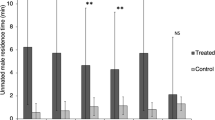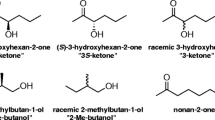Abstract
Female sex pheromones ofPeriplaneta americana, P. australasiae, andBlatta orientalis elicit locomotion and upwind orientation in conspecific males. Interspecific attraction between these species was observed in a wind tunnel assay for most species combinations, with the exception ofP. australasiae males not being attracted toP americana females. The role of twoP. americana sex pheromone components, periplanone-A (PA) and periplanone-B (PB) in male attraction was analyzed. PA induced locomotion in males of all three species, with highest threshold concentration inP. americana. PB was effective inP. americana andB. orientalis, but not inP. australasiae. Experiments with mixtures of both components confirmed an inhibitory influence of PB onP. australasiae males when it was added to PA in a ratio of 3∶1 or higher. SinceP. americana andP. australasiae have been found to be syntopous, and their daily mating periods overlap, the female sex pheromone ofP. americana is discussed as an isolating factor between both species.
Similar content being viewed by others
References
Bell, W.J. 1982. Pheromones and behavior, pp. 371–397,in W.J. Bell and K.G. Adiyodi (eds.). The American Cockroach. Chapman and Hall, London.
Block, E.F., andBell, W.J. 1974. Ethometric analysis of pheromone receptor function in cockroaches,Periplaneta americana.J. Insect Physiol. 20:993–1003.
Bradshaw, J.W.S., Baker, R., andLisk, J.C. 1983. Separate orientation and releaser components in a sex pheromone.Nature 304:265–267.
Cardé, R.T., Baker, T.C., andRoelofs, W.L. 1975. Ethological function of components of a sex attractant system for Oriental fruit moth males,Grapholita molesta.J. Chem. Ecol. 1:475–491.
Collins, M.M., andTuskes, P.M. 1979. Reproductive isolation in sympatric species of dayflying moths (Hemileuca; Saturniidae).Experientia 33:728–733.
Cornwell, P.B. 1968. The Cockroach. Hutchinson & Co., London.
Grant, G.G. 1977. Interspecific pheromone responses of tussock moths and some isolating mechanisms in eastern species.Environm. Entomol. 6:739–742.
Inscoe, M. 1977. Chemical communication in insects.J. Wash. Acad. Sci. 67:16–33.
Kaissling, K.-E. 1979. Recognition of pheromones by moths, especially in Saturniids, andBombyx mori, pp. 43–56,in F.J. Ritter (ed.). Chemical Ecology, Odour Communication in Animals. Elsevier/North Holland Biomedical Press, Amsterdam.
Kramer, E. 1978. Insect pheromones, pp. 207–229,in G.L. Hazelbauer (ed.). Taxis and Behavior. Chapman and Hall, London.
Persoons, C.J. 1977. Structure elucidation of some insect pheromones: A contribution to the development of selective pest control agents. PhD thesis. Agricultural University, Wageningen, Holland.
Roelofs, W.L. 1979. Production and perception of lepidopterous pheromone blends, pp. 159–180,in R.J. Ritter (ed.). Chemical Ecology: Odour Communication in Animals. Elsevier/North Holland Biomedical Press, Amsterdam.
Roth, L.M., andWillis, E.R. 1960. The biotic associations of cockroaches.Smithson. Misc. Coll. 141:1–470.
Sass, H. 1983. Production, release and effectiveness of two female sex pheromone components ofPeriplaneta americana.J. comp. Physiol. 152:309–317.
Schafer, R. 1977. The nature and development of sex attractant specificity in cockroaches of the genusPeriplaneta. III. Normal intra-and interspecific behavioral responses and responses of insects with juvenile hormone-altered antennae.J. Exp. Zool. 199:73–84.
Seelinger, G. 1984. Sex-specific activity patterns inPeriplaneta americana and their relation to mate-finding.Z. Tierpsychol. 65:309–326.
Seelinger, G. 1985. Behavioral responses to female sex pheromone components inPeriplaneta americana. Anim. Behav. In press.
Seelinger, G., andSchuderer, B. 1985. Release of male courtship display inPeriplaneta americana: Evidence for female contact sex pheromone.Anim. Behav. In press.
Simon, D., andBarth, R.H. 1977a. Sexual behavior in the cockroach generaPeriplaneta andBlatta. I. Descriptive aspects.Z. Tierpsychol. 44:80–107.
Simon, D., andBarth, R.H. 1977b. Sexual behavior in the cockroach generaPeriplaneta andBlatta. IV. Interspecific interactions.Z. Tierpsychol. 45:85–103.
Tumlinson, J.H., andTeal, P.E.A. 1982. The sophisticated language of insect chemical communication.J. Ga. Entomol. Soc. 17:11–22.
Waldow, U., andSass, H. 1984. The attractivity of the female sex pheromone ofPeriplaneta americana and its components for conspecific males and males ofPeriplaneta australasiae in the field.J. Chem. Ecol. 10:997–1006.
Wharton, D.R.A., Miller, G.L., andWharton, M.L. 1954. The odorous attractant of the American cockroach,Periplaneta americana. II. A bioassay method for the attractant.J. Gen. Physiol. 37:471–481.
Author information
Authors and Affiliations
Rights and permissions
About this article
Cite this article
Seelinger, G. Interspecific attractivity of female sex pheromone components ofPeriplaneta americana . J Chem Ecol 11, 137–148 (1985). https://doi.org/10.1007/BF00988196
Received:
Accepted:
Issue Date:
DOI: https://doi.org/10.1007/BF00988196




